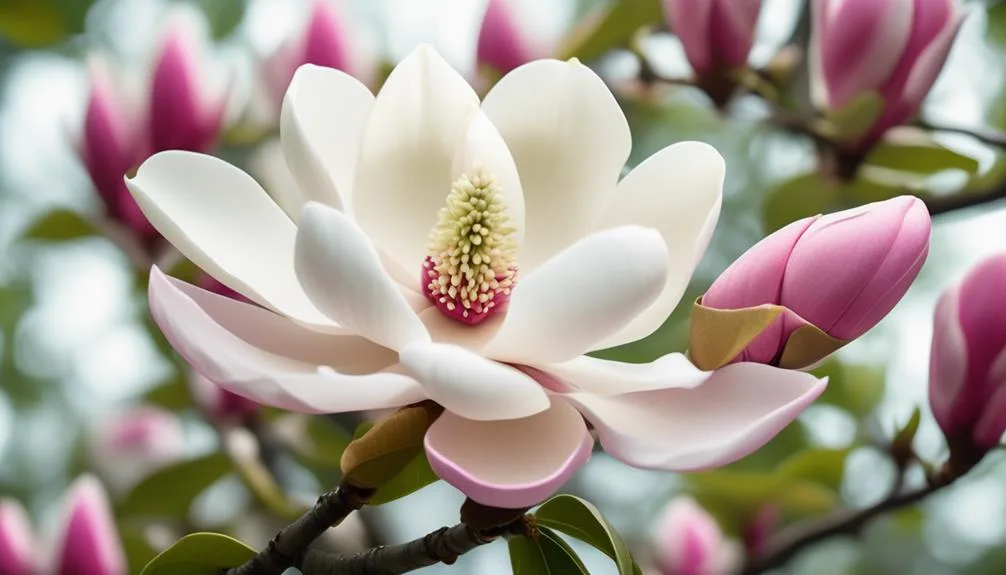Have you ever wondered if you can eat the flowers of a magnolia tree?
The beautiful, fragrant blossoms may look tempting, but before you consider taking a bite, it's important to learn about their edibility.
We'll discuss the nutritional value of magnolia flowers, how they can be used in cooking, and any precautions to keep in mind before trying them.
Stick around to find out more about this floral curiosity.
Edibility of Magnolia Tree Flowers
You can safely consume the delicate, fragrant blossoms of the magnolia tree, adding a unique and subtle floral flavor to your culinary creations.
These beautiful flowers aren't only visually appealing but also offer potential medicinal benefits. Magnolia flowers have been used in traditional medicine for their anti-inflammatory and anti-anxiety properties.
When used in cooking, they bring a delightful aroma and flavor to various dishes, from salads to desserts.
Additionally, incorporating magnolia flowers into your diet can have a positive environmental impact. By utilizing the blossoms, you're promoting the sustainable use of natural resources and reducing waste.
With their versatility and potential health benefits, magnolia tree flowers are a delightful addition to any kitchen.
Nutritional Value of Magnolia Flowers
With a delicate and subtle flavor, magnolia flowers offer a surprising array of essential nutrients, making them a valuable addition to your culinary repertoire. These beautiful flowers aren't only visually appealing but also packed with health benefits.
Magnolia flowers are rich in antioxidants, which help in reducing oxidative stress and inflammation in the body. They also contain essential nutrients such as vitamin C, calcium, and fiber, contributing to overall well-being.
In terms of culinary applications, magnolia flowers can be used in various cooking methods, including as an edible garnish, in salads, or steeped to make a fragrant tea. Their nutrient content and versatility make them an exciting and nutritious ingredient to experiment with in the kitchen, adding both flavor and potential health benefits to your dishes.
Culinary Uses of Magnolia Flowers
Packed with an array of essential nutrients and a delicate, subtle flavor, magnolia flowers offer a unique culinary experience that extends beyond their visual appeal.
The flowers can be used in various cooking methods, including being added raw to salads for a pop of color and a lightly citrusy taste. You can also experiment with frying them in a light batter for a crispy texture and delicate floral notes.
Furthermore, infusing the petals into syrups or teas can impart a fragrant, floral sweetness to your beverages and desserts. The flavor profiles of magnolia flowers are often described as citrusy, with hints of vanilla and a subtle sweetness, making them a versatile ingredient in both sweet and savory dishes.
When using magnolia flowers, it's essential to ensure they're sourced from non-toxic varieties and are free from pesticides for safe consumption.
Precautions When Eating Magnolia Flowers
When incorporating magnolia flowers into your culinary creations, it's important to be mindful of potential allergic reactions and to source the flowers from safe, pesticide-free varieties. Magnolia flowers are generally safe to eat, but it's crucial to take certain precautions to ensure a pleasant and risk-free culinary experience. Here are some safety tips to consider when using magnolia flowers in your cooking:
- Identify safe varieties: Ensure that the magnolia flowers you intend to use are from non-toxic species and haven't been treated with pesticides.
- Allergy check: Before consuming magnolia flowers, perform a small allergy test by ingesting a small amount to check for any adverse reactions.
- Proper preparation: Thoroughly wash the flowers to remove any potential contaminants before use.
- Moderation: Consume magnolia flowers in moderation to minimize the risk of any potential dangers associated with overconsumption.
Conclusion: Are Magnolia Tree Flowers Edible?
To determine the edibility of magnolia tree flowers, it is essential to consider their culinary applications and potential health considerations. Magnolia flowers are indeed edible and have been used in various culinary creations for centuries. They offer a delicate, slightly citrusy flavor that can enhance both sweet and savory dishes. However, it's important to note that not all magnolia species produce edible flowers, so it's crucial to identify the specific variety before using the flowers in recipes. Additionally, while magnolia flowers can add a unique floral twist to dishes, it's essential to use them in moderation due to potential allergic reactions in some individuals. Here's a simple breakdown of the culinary applications and potential health considerations of magnolia tree flowers:
| Culinary Applications | Potential Health Considerations |
|---|---|
| – Edible flowers can be used in salads and desserts. | – Use in moderation due to potential allergic reactions. |
| – Floral recipes such as magnolia flower sorbet or infused syrups. | – Identify the specific magnolia variety to ensure edibility. |
Conclusion
Magnolia tree flowers offer more than just beauty – they can be a delightful addition to culinary creations. With their sweet flavor and potential health benefits, these edible blooms add a unique touch to dishes and drinks.
When foraging for magnolia flowers, it's crucial to select non-toxic species and steer clear of harmful chemicals.
Embracing these blooms in moderation can bring a touch of elegance and flavor to your table.

My interest in trees started when I first saw the giant sequoias in Yosemite.
I was a teenager then, and I remember thinking, “I need to learn more about this.”
That moment stuck with me.
A few years later, I went on to study forestry at Michigan Tech.
Since graduating, I’ve worked in a mix of hands-on tree care and community education.
I’ve spent over ten years helping people understand how to plant, maintain, and protect the trees in their neighborhoods.
I don’t see trees as just part of the landscape.
They are living things that make a real difference in our daily lives.
